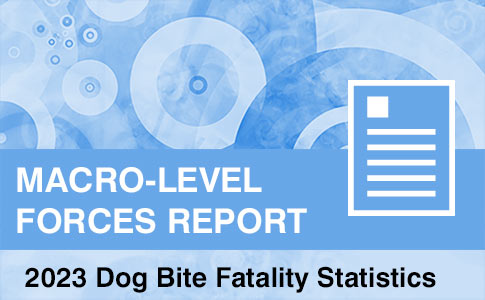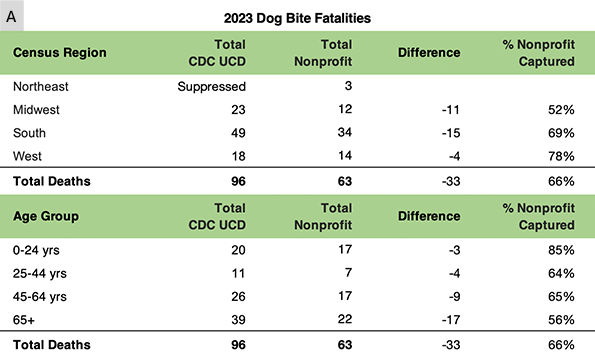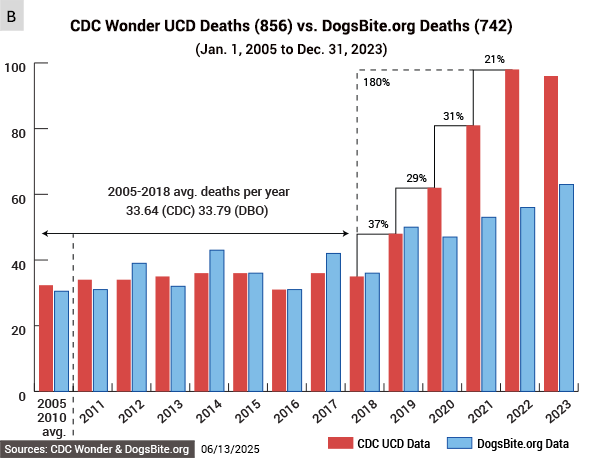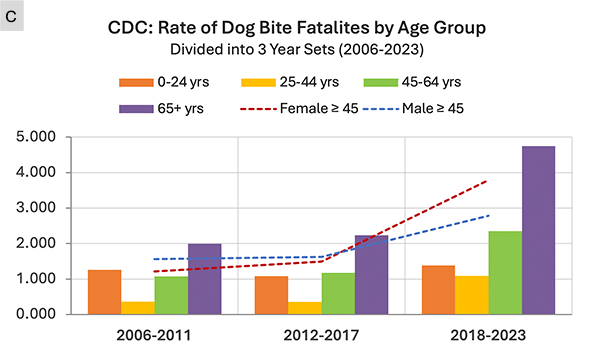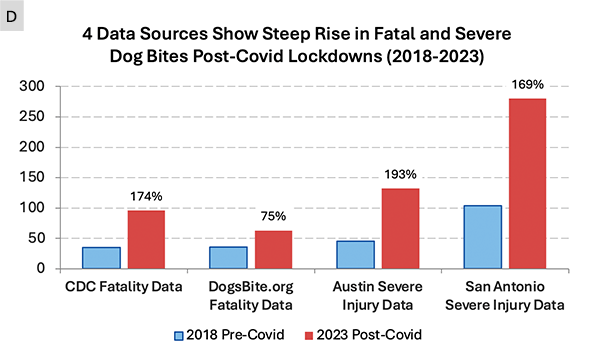Austin and San Antonio Severe Injury Dog Bite Data Pre- and Post-Covid
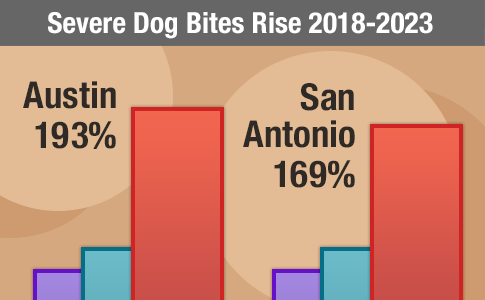
Austin, TX - Since 2022, we have been reporting a steep rise in dog bite fatalities in CDC Wonder data during the Covid and post-Covid years. In October, we published our 2022 Macro-Level Forces Report. We discussed the rise in the total number of deaths to 98 -- the highest ever recorded in CDC Wonder data -- and a 180% rise since 2018 (from 35 deaths to 98). Our hypothesis quickly became that if Covid-era dog bite fatalities have almost tripled since 2018 then severe injury dog bites have too.
98 fatal dog attacks in a single year are the most ever recorded by CDC data. This is a 104% increase from 2019 and a 180% increase from 2018.
In 2024, we obtained dog bite injury severity data over a 12-year period (2012-2023) from two Central Texas cities, Austin, where DogsBite.org is located, and San Antonio. By January 2024, news reports showed that severe bites had nearly tripled in both cities since 2018. Over the course of 2024, we spent months examining this data to see if specific trends stood out. Several do, including: the rising number of victims ≥ 40-years old, the breed of dog involved, and no-kill animal shelter polices.
"Sustained Effect"
Last August, the first paper was published showing that dog bite injuries are increasing in frequency and severity, demonstrating a "sustained effect" post-Covid. The UK study analyzed dog bite injuries in a plastic surgery department at a trauma center before and after Covid lockdowns, 2018 and 2022, respectively. The study showed that dog bites have increased in frequency and severity with a clear increase in "deeper tissue injuries, tissue loss and muscle, nerve, vascular or bone involvement."
The increasing frequency and severity of dog bite injuries from 2018 to 2023 is also reflected in the Central Texas dog bite data that we obtained.
Data from Austin and San Antonio are also ripe to be examined because they both collect injury severity data (Minor, Moderate and Severe), which is rare among cities. We examined the years 2012 through 2023 of both cities with an emphasis on 2018 to 2023, which shows the "sustained effect" post-Covid. In the Austin data set, we examined injury severity, age of victims, the top-biting breeds, and multi-dog bites. In the San Antonio data set, we examined injury severity and age of victims.
Austin Dog Bite Data (2012-2023)
Background
In September 2023, the city released an audit of the Austin Animal Center (AAC), which bills itself as one of the top "no-kill" shelters in the country. The audit states the "Council-mandated" live release rate of 95% has come at the expense of animals under AAC's care and negates AAC's ability to serve as an open-intake shelter for the community. AAC is routinely over-capacity and closes intake of new animals due to overcrowding and failing to euthanize for behavior, which affects public safety.
In January 2024, AAC released data about the steep rise in Severe Bite Injuries (SBI) -- from 2018 to 2023, SBIs nearly tripled.1 AAC also reiterated the audit's data showing that AAC adopted or transferred out 352 dogs with a "Moderate" or "Severe" bite history since 2019. "Unfortunately, AAC has experienced several instances where a dog with a known significant bite history has caused severe injury to members of the public after the dog was released," states the January report.2,3
The SBI data from AAC and the data from the audit -- showing that AAC has recycled hundreds of dogs with moderate and severe bite histories back into the city -- resulted in the city adopting the Ian Dunbar Bite Scale, which evaluates bite severity from Level 1 to 6, Level 6 being death. Dogs that have inflicted a Level 4 bite or higher can no longer be adopted to the public and "may be euthanized" without making them available to a rescue group. The city adopted this policy in February 2024.
Prior to adopting the Dunbar Bite Scale, AAC was subject to a "Right to Rescue" ordinance passed in October 2019, pushed by extreme "no-kill" activists to stop AAC from performing most "behavior euthanasia" for public safety purposes.4 Seven months earlier, in March 2019, no-kill zealots pushed the city to pass a 95% "save rate" resolution, above the arbitrary 90% "save rate."5 Thus, by the end of 2023, AAC had recycled hundreds of biting dogs back into the city and SBIs had nearly tripled.
Coinciding Timeframe
The timeframe of these no-kill shelter policies coincides with the sharp rise of SBIs in Austin. The volume of serious bite dogs AAC adopted or transferred back into the community, 352, also coincides with the sharp rise of SBIs in Austin during this period. The city admitted that some of the biting dogs bit again and contributed to the 193% rise in severe bite injuries from 2018 to 2023. No-kill policies enacted in 2019 directly correlate to the increasing frequency of severe bite injuries in the city.
"Dogs that have a bite history of level 4 or higher on the Dunbar bite scale may be euthanized without making them available ... This recommendation is borne from a public safety perspective, namely the number of known bite dogs that have caused the public severe injuries after having been released from the AAC." - City of Austin Council Work Session, January 30, 2024
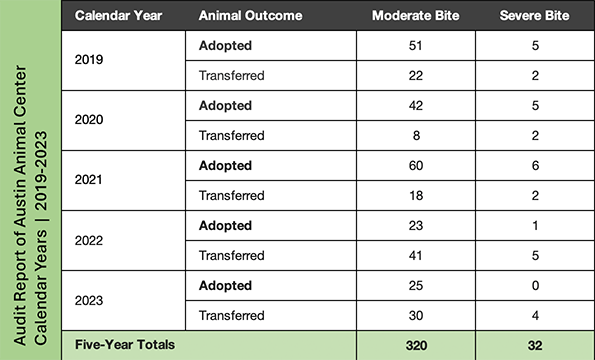
The Austin City Auditor's report showed that AAC adopted or transferred out 352 dogs with moderate or severe bite histories over the 5-year period of 2019 to 2023.
Austin Dog Bites: Severity & Age Groups
From 2018 to 2023 (nonfiscal), SBIs increased 193% (45/132) in Austin. By comparison, minor injury bites -- the most frequent injury level -- fell by 27% (1463/1062), and moderate injury bites -- the second most frequent -- only rose by 49% (326/485). The chart shows that severe and moderate bites rose the most during the Covid years of 2021 to 2023. Among age groups, severe injury bites rose the most in ≥ 40 years old, 433%, followed by, 1-9 years old, a 275% rise, and 10-39 years, a 117% rise.
Page 2 of the Severity & Age Group report, which extends the charts back to 2012, shows the rise of severe bite injury victims ≥ 40 years old began in 2019, before the pandemic. Within this subset, 40-49 years rose the most over the 12-year period, nearly doubling in the number of severe bites between the two 6-year periods (2012-2017 to 2018-2023) from 39 to 77, a 97% rise. Followed by ≥ 70-years, which also had a nearly a doubling of incidents between the two periods from 12 to 22, an 83% rise.
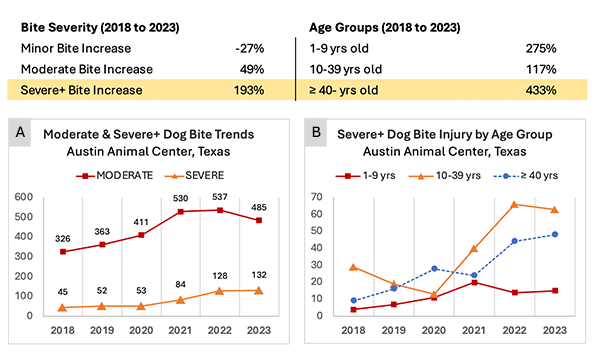
Dog bite injuries by severity and age group (2012-2023) before, during and after Covid, emphasizing the rise in severe injury dog bites in the city of Austin between 2018 to 2023.
Austin Dog Bites: Top-Biting Breeds & Severity
The Biting Breeds & Severity report shows the top-biting breeds of (1) all severity levels and (2) severe bite injuries alone between 2012 and 2023.6 Among all severity levels, pit bulls were responsible for 22% (4888/21911), over twice as high as any other dog breed. Among severe bite injuries, pit bulls were responsible for 42% (357/842), over 4 times higher than any other dog breed. Among the years we are primarily focused on, 2018-2023, severe bites inflicted by pit bulls rose 533%, from 12 to 76.
Thus, the near tripling of severe bites in Austin from 2018 to 2023 points to pit bulls as the chief perpetrator, responsible for 47% (234/494), combined with the total number of dogs with significant bite histories that AAC recycled back into the city, and the "sustained effect" post-Covid. Among severe bites inflicted by the other top-biting breeds over the 12-year period, there is little variance. As Chart G shows, there is an explosion of severe bite injuries inflicted by pit bulls from 2018 to 2023.
Page 2 of the Biting Breeds & Severity report shows the top 10 biting breeds for each severity level over the 12-year period. Pit bulls inflicted 42% of severe bites, over 4 times more than the next breed, Labrador retrievers, 10%, and German shepherds, 5%. Pit bulls inflicted 27% of moderate bites, over 2 times more than the next breed, Labradors, 12%, and German shepherds, 8%. Pit bulls inflicted 20% of minor bites, over 1.75 times more than the next breed, Labradors, 11%, and Chihuahuas, 10%.7
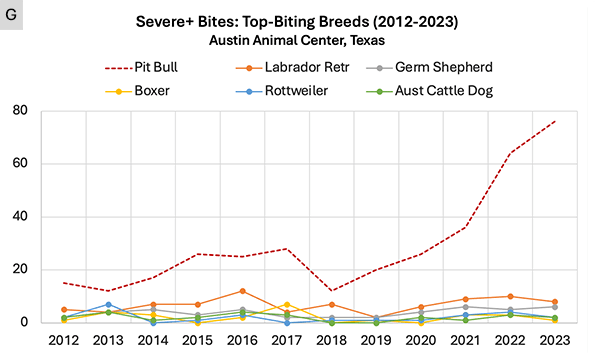
Top-biting breeds of severe injures by year (2012-2023), emphasizing the rise in severe dog bite injuries by the top-biting breeds in the city of Austin between 2018 to 2023.
Austin Dog Bites: Multi-Dog Bites & Severity
We also examined if bites involving multiple dogs ("multi-dog bite") significantly added to the rise of SBI events from 2018 to 2023. For example, in 2022 a 41-year old Austin man was killed by 6 pit bulls. This was recorded as 6 severe bites. From 2012 to 2017, multi-dog bites comprised 29% of all severe bite injuries. This fell to 24% from 2018 to 2023. Severe multi-dog bites involving pit bulls comprised 37% during the 2012 to 2017 period. During the second period, 2018 to 2023, that rose to 70%.
From 2018 to 2023, pit bulls were disproportionately involved in severe bite injuries, 47% (234/494), and severe multi-dog bite injuries, 70% (85/121).
If only unique SBIs are counted -- meaning the Austin fatality would count as 1 SBI event instead of 6 -- unique severe bites from 2018 to 2023 still nearly tripled. Instead of rising 193% (from 45 to 132), unique SBIs rose 190% (from 41 to 119). As Chart K illustrates, multi-dog bites are always a portion of severe bites, but that portion actually fell slightly during the 2018 to 2023 period. Severe injury bites involving multiple dogs did not abnormally impact the overall rise of SBI events from 2018 to 2023.8
This is also true in our dog bite fatality data, perhaps because owning a pair of dogs is common. Yet, there has been a sharp rise in deaths involving 3 or more dogs -- from 5 deaths in 2018 to 22 in 2023, a 340% rise. While all dog bite fatalities have risen annually since 2018 -- from 36 deaths in our data to 61, a 69% rise -- deaths are rising slower than attacks involving ≥ 3 dogs.9 Austin data only tracked if "multiple dogs" were involved, not the "actual number" of dogs, so we could not measure this factor.
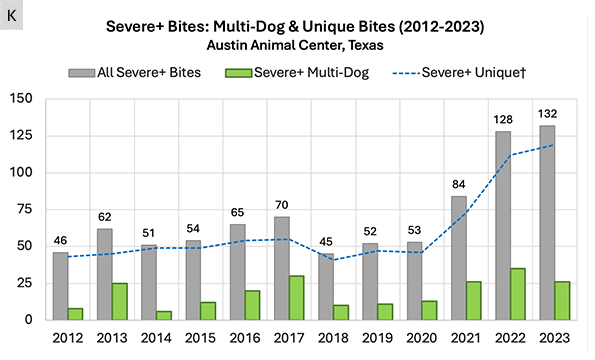
Severe injury multi-dog bites and unique bites (2012-2023), emphasizing the influence of multi-dog bites on all severe injury bites in the city of Austin between 2018 to 2023.
Austin Dog Bites: Summary
Over the 6-year period of 2018 to 2023, minor bites fell in Austin by 27%, moderate bite injuries rose by 49%, and severe bites rose by 193% -- indicating a disproportionate increase in severe bites. Victims 40 years and older had the greatest increase in severe bites, 433%, especially those aged 40-49 and 70 and older. Over the 12-year period, pit bulls were responsible for 42% of severe bites, over 4 times more than any other breed. From 2018 to 2023, severe bites inflicted by pit bulls surged 533%.
Multi-dog attacks involving severe injuries did not distort these results. From 2018 to 2023, unique severe bites rose 190%, similar to the escalation in all severe bites, which rose 193%. This period directly correlates with the 95% save rate mandate and a "Right to Rescue" no-kill ordinance, both adopted in 2019, which led to AAC recycling hundreds of biting dogs back into the city. In 2024, the city adopted the Dunbar Bite Scale to stop rehoming dogs with a Level 4 or higher bite history.
San Antonio Dog Bite Data (2012-2023)
Background
After a series of five brutal dog attacks in 2023, including the fatal pit bull maulings of Ramon Najera, 81, and Paul Striegl, 47, local media began scrutinizing San Antonio Animal Care Services (ACS) data, including dog bite severity data, owner citations, repeat offenders, and more. This is when it became known that both San Antonio and Austin sustained a near tripling of severe injury bites from 2018 to 2023, but only a minor difference or a reduction in the number of minor and moderate bites.
The death of Najera resulted in criminal charges, the owners pleading guilty and a punishment phase proceeding. Christian Moreno and Abilene Schnieder, a married couple, were each sentenced to lengthy prison terms in connection to his death, 18 and 15 years, respectively. Najera's wife then filed a federal lawsuit against San Antonio, alleging the city's "misfeasance, and gross misconduct" for failing to declare the couple's dogs dangerous after inflicting three attacks prior to killing her husband.
After Najera's death, the city launched a strategic plan to increase responsiveness to bites and dangerous dog investigations. By the end of fiscal 2024, increases in budget and staffing led to a critical call response rate of 81%, up from 46%; dangerous dog compliance rose to 82% from 55%; and criminal citations increased 221%. Today, any dog picked up by ACS is subject to spay or neuter to reduce roaming dogs, and victims can sign a dangerous dog affidavit under a pseudonym program.
Despite these improvements, severe bite injuries have increased 54% so far this year. When asked why, ACS Director Jon Gary said, "We don't know."10
San Antonio operates on a similar dog bite injury scale as Austin. The three severity levels in San Antonio are Mild, Moderate, and Severe. We did not obtain breed data because it is already known from 2017 data that pit bulls inflicted 47% of severe bites in San Antonio, over 3 times more than any other breed. In 2023 data, pit bulls inflicted at least 31% of injuries resulting in "hospitalization or death" -- a separate severity designation11 -- which is over 4 times more than any other dog breed.
We also did not obtain records of bite dogs adopted from the city shelter. What is known is that ACS had an 88% "save rate" in 2022, and an 81% rate in 2023, both fall short of the 90% requirement for no-kill. In 2024, under the new leadership of Gary, the save rate rose to 87%, apparently due to a new incentive for rescue partners to pull animals from the shelter at $200 per animal, up from $84. Maintaining a 90% save rate is a priority for San Antonio, but their public safety priority is higher.
San Antonio Dog Bites: Severity & Age Groups
From 2018 to 2023 (fiscal), severe bite injuries rose 169% in San Antonio. By comparison, mild injury bites -- the most frequent -- fell by 2% (1750/1708), and moderate injury bites -- the second most frequent -- only rose by 18% (710/835). The chart shows that severe and moderate bites rose the most during the Covid years of 2021 to 2023. Among age groups, severe injury bites rose the most in ≥ 40 years old, 396%, similar to Austin, followed by 10-39 years, a 138% rise, and 1-9 years old, a 117% rise.
Page 2 of the Severity & Age Group report, which extends the charts back to 2012, shows the rise of severe bite injury victims ≥ 40 years old began in 2020, the first year of the pandemic. Within this subset, ≥ 70 years rose the most over the 12-year period, more than doubling in the number of severe bites between the two 6-year periods (2012-2017 to 2018-2023) from 29 to 71, a 145% rise. Followed by 60-69-years, where SBIs also more than doubled between the periods from 30 to 61, a 103% rise.
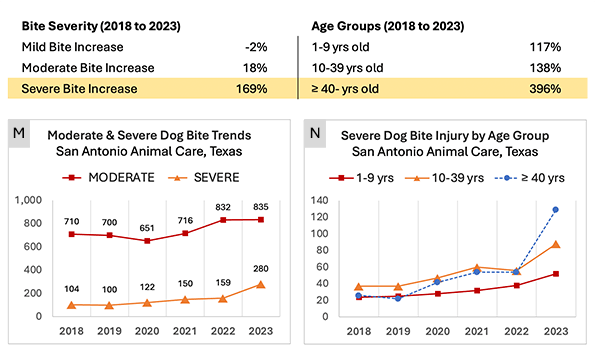
Dog bite injuries by severity and age group (2012-2023) before, during and after Covid, emphasizing the rise in severe injury dog bites in San Antonio between 2018 to 2023.
San Antonio Dog Bites: Summary
The similar trends in San Antonio and Austin cannot be ignored. Each experienced a sharp rise in the number of severe bites, 169% and 193% respectively. Each also experienced a sharp rise in the number of victims ≥ 40 years old, 396% and 433% respectively. Among the ≥ 40 age groups, the ≥ 70 age group rose the most in San Antonio, and the 40-49 age group rose the most in Austin. According to Census data, San Antonio has a higher number of people ages ≥ 65, 13.1% versus 10.1%.
After five brutal dog attacks in 2023, the city committed to a strategic plan to increase dangerous dog investigations and owner compliance. The results have been encouraging. Key public safety metrics have sharply risen, and the fine for a first offense for owning a biting dog is now $1,000. To combat the city's "enduring roaming dog" problem, any dog ACS finds roaming will be spay or neutered before being released to its owner. But an alarming increase in severe bite injuries continues to persist.
Summary & Discussion
Injury & Breed Data
In two Central Texas cities, Austin and San Antonio, Severe Bite Injuries (SBI) nearly tripled between 2018 and 2023. Moderate injury bites grew more modestly, 49% and 18%, respectively, and minor injury bites fell, -27% and -2% respectively. In both jurisdictions, dog bite victims in the ≥ 40 years age group increased dramatically, 433% in Austin and 396% in San Antonio. The top-biting breed in both cities -- pit bulls -- disproportionately inflicted the greatest number of severe and fatal bite injuries.
In Austin, severe injury bites inflicted by pit bulls shot up 533% from 2018 to 2023. No other breeds had a significant rise. In 2023 alone, pit bulls inflicted 58% of severe and life-threatening bites in Austin, over 9 times more than any other dog breed. In San Antonio, pit bulls inflicted 31% of injuries resulting hospitalization or death during 2023, over 4 times more than any other breed. In both cities, a single breed of dog, pit bulls, heavily contributed to the near tripling of SBIs over the last 6 years.
No-Kill Policies
In Austin, at least two no-kill shelter polices adopted in 2019, the "Council mandated" live release rate of 95% and the "Right to Rescue" ordinance, contributed to the rise in SBIs between 2018 to 2023. Over the same period, AAC recycled hundreds of high-risk dogs with bite histories back into the city. By the end of 2023, SBIs had nearly tripled. A course correction included the city adopting the Dunbar Bite Scale. Dogs with a Level 4 bite history or higher can no longer be adopted to the public.
We also know that in Austin, dog owners became more tolerant of keeping dogs that lack bite inhibition in their homes. From 2012 to 2017, 81 severe injury bites occurred on properties where the "same" dog had another recorded bite by AAC. From 2018 to 2023, that number more than doubled to 173, a 114% rise. Also, during the first period, 390 moderate injury bites occurred on properties where the "same" dog had another recorded bite history by AAC. That rose to 624 in the second period, a 60% rise.12
Severe Bites Keep Rising
In San Antonio, despite implementing a strategic plan to increase responsiveness to bites and dangerous dog investigations and achieving strong results between fiscal years 2023 and 2024, it was announced in May that severe bites increased 54% from the same period in fiscal 2024. Bites of all severity levels rose 11% -- indicating, again, a disproportionate increase in severe bites. If this rise continues at a 54% increase through the end of fiscal 2025, this will result in a 314% rise since 2018.
The surge in severe bites in San Antonio may be linked to more families keeping a biting dog, and more owners who lack the know-how and resources to manage a biting dog. The ACS director hypothesized the rise in severe bites might be linked to a rise in the number of free-roaming dogs. In our nonprofit's research, Covid exacerbated the free-roaming dog problem across the country, as spay and neuter services were slowed or halted and animal control agencies only responded to high priority calls.
National and International Trends
The 2024 UK paper, which is the first to show that dog bite injuries are increasing in frequency and severity following the pandemic, identified the trend as a "sustained effect" post Covid. Their analysis showed a 47% increase in dog bites after lockdowns ended compared to before, and a significant increase in the need for operative management. Covid changed various aspects of society, including patterns of human-animal interactions. More people became dog owners during this period as well.
On a state-level, two states have released comprehensive pre- and post-Covid dog bite injury data for emergency room visits. In California, the number of ER visits for dog bites increased 12% from 2021 to 2022. Additional data from the California Department of Health Care Access and Information shows that from 2018 to 2023, the number of ER visits for dog bites increased from 42277 to 54682, a 29% rise. 2023 marks the highest number of ER visits for dog bites in California in the last 19 years.
Data from the Florida Department of Health shows an even higher rise. From 2021 to 2022, the number of ER visits for dog bites increased 19%. From 2018 to 2023, the number of these ER visits increased from 24001 to 32557, a 36% rise. 2023 also marked the highest number of ER visits for dog bites in Florida in the last 19 years. The rate of these ER visits differ between the two states. In 2023, the rate of ER visits for dog bites in Florida was 179 per population 100,000. In California, the rate was 139.5.
Nationally, the number of U.S. households that own a dog is growing, the American Veterinary Medical Association reports. Our research indicates public tolerance for keeping a biting dog is also growing. According to a national no-kill organization, 57% of U.S. shelters achieved a 90% or higher save rate in 2022.13 Many no-kill shelters practice "managed intake," and avoid behavior-based euthanasia. These dogs are then recycled back into the community, just like AAC had been doing before the audit.
Mitigation Strategies
A powerful method of unbiased inspection is an audit. In Austin, the auditor's office underwent an extensive examination of AAC data that led to the discovery that AAC had placed over 350 dogs with moderate and severe bite histories into the city since 2019, contributing to a steep rise of severe bite Injuries. As a result, the city adopted the Dunbar Bite Scale, an objective injury scale, stating that dogs with a bite history of Level 4 or higher cannot be adopted to the public and may be euthanized.
Another mitigation strategy is for state legislators to enact a mandatory bite disclosure law, forcing animal releasing agencies to disclose the animal's bite history to the adopter -- California and Virginia already have. The combination of a bite disclosure law and a city adopting the Dunbar Bite Scale is even better. When Austin adopted the scale, the terms "provoked" and "unprovoked" were removed from the ordinance, because the city decided "to move to an objective measure of bite severity."
Owners with a biting dog must candidly consider its "management," because the best predictor of a bite is a previous bite. The degree of injury in each new bite often escalates. Can the biting dog and its legal liability be "managed" or not? If the answer is no, or is cost prohibitive, what is the next step? Prior to no-kill sheltering policies, responsible owner management of a serious biting dog was to surrender it to the local pound for euthanasia. Many no kill shelters turn away these owners today.
The Last Word
By Attorney Kenneth M. Phillips
After reviewing our report, the nation's most prominent dog bite attorney and the author of dogbitelaw.com offers additional findings and conclusions by providing the last word.
There are many reasons why more people are being seriously injured by dogs today, but the primary cause is the growing number of pit bulls in the United States. Although pit bulls make up only about 6% of the nation’s dog population, they are responsible for a disproportionate number of severe and fatal attacks.
When I refer to a pit bull, I include not just the American Pit Bull Terrier, but all breeds and mixes with the same fighting-dog background and behavioral traits—such as the Bully, Staffy, Amstaff, Blue Nose, and Red Nose. These dogs share a common genetic heritage and physical characteristics that make them more likely to inflict serious injuries when they attack.
Meticulous research supports this conclusion. For example, Colleen Lynn's analysis of dog bite records in Austin, Texas, revealed a 533% increase in severe attacks by pit bulls. In my own legal practice, which is exclusively focused on dog bite cases, pit bulls are involved in the vast majority of the catastrophic injuries and deaths. When I review a fatal attack, the dog responsible is almost always a pit bull.
The rise in pit bull ownership in the USA has brought with it more attacks, more physical trauma, longer recovery times, and higher medical expenses. Numerous hospitals and researchers have documented this trend. One dramatic statistic is that pit bulls are currently responsible for approximately 75% of fatal dog attacks in the United States.
Shelters and rescues have contributed to the crisis by rehoming large numbers of pit bulls. Families who come to a shelter looking for a safe, friendly pet are often misled into adopting a dog with a history of aggression. I’ve recovered millions of dollars for clients injured in such cases—only to see the same shelter continue placing aggressive dogs into other homes. This is why I have called for all states to adopt a “Truth in Pet Adoption Law” that would require shelters and rescues to disclose a dog’s bite history in writing before adoption. No reasonable parent would knowingly bring a dangerous dog into their home.
No-kill shelter policies have made matters worse. Nearly every day in my practice, I receive calls from adopters, fosters, shelter workers or volunteers who have been bitten by dogs that should have been euthanized. All across the country, aggressive dogs—especially pit bulls—are being returned to the same neighborhoods where they previously injured people.
The pit bull advocacy movement has added to the problem by promoting the idea that these dogs are simply intelligent, friendly, loyal, and misunderstood. But advocates often fail to mention that when pit bulls attack, their victims are frequently their own owners, their owner's family members, or visiting children. This incomplete narrative leads to real harm:
- People adopt pit bulls without understanding the risks
- Owners of small dogs do not take steps to protect them
- Pit bull owners fail to protect themselves or their families
- People and pets suffer maulings that could have been prevented
A recent attack in Manhattan highlights another serious issue: the failure of law enforcement to act. In that case, a Chihuahua named Penny was mauled outside a sidewalk café. The NYPD refused to take action, falsely claiming it lacked the authority to impound two clearly dangerous pit bulls owned by irresponsible individuals. When animal control laws are ignored, people and pets suffer avoidable injuries.
Are all pit bulls alike? No. But every pit bull poses a level of risk that is simply too high for the average household. The only effective way to reduce that risk is to reduce the number of pit bulls overall. Public shelters and rescues should stop or greatly reduce the rehoming of pit bulls. Breeders should stop producing them.
The focus should not be on the breed’s image, but on public safety. And that means fewer pit bulls in our communities.
Kenneth M. Phillips
dogbitelaw.com

Chart Key: Rising Dog Maulings in two Central Texas Cities, Austin & San Antonio (2018-2023)
Download report files:
Report: Austin Dog Bites - Injury Severity & Age Groups (2012-2023)
Report: Austin Dog Bites - Top-Biting Dog Breeds & Severity (2012-2023)
Report: Austin Dog Bites - Multi-Dog Bites & Severe Bites (2012-2023)
Report: San Antonio Dog Bites - Injury Severity & Age Groups (2012-2023)
See: Full news release
Related articles:
Macro-Level Forces Report: Covid Impacts of 2022 U.S. Dog Bite Fatality Capture Rate of Nonprofit
Macro-Level Forces Report: Covid Impacts of 2021 U.S. Dog Bite Fatality Capture Rate of Nonprofit
Macro-Level Forces Report: Covid Impacts of 2020 U.S. Dog Bite Fatality Capture Rate of Nonprofit
